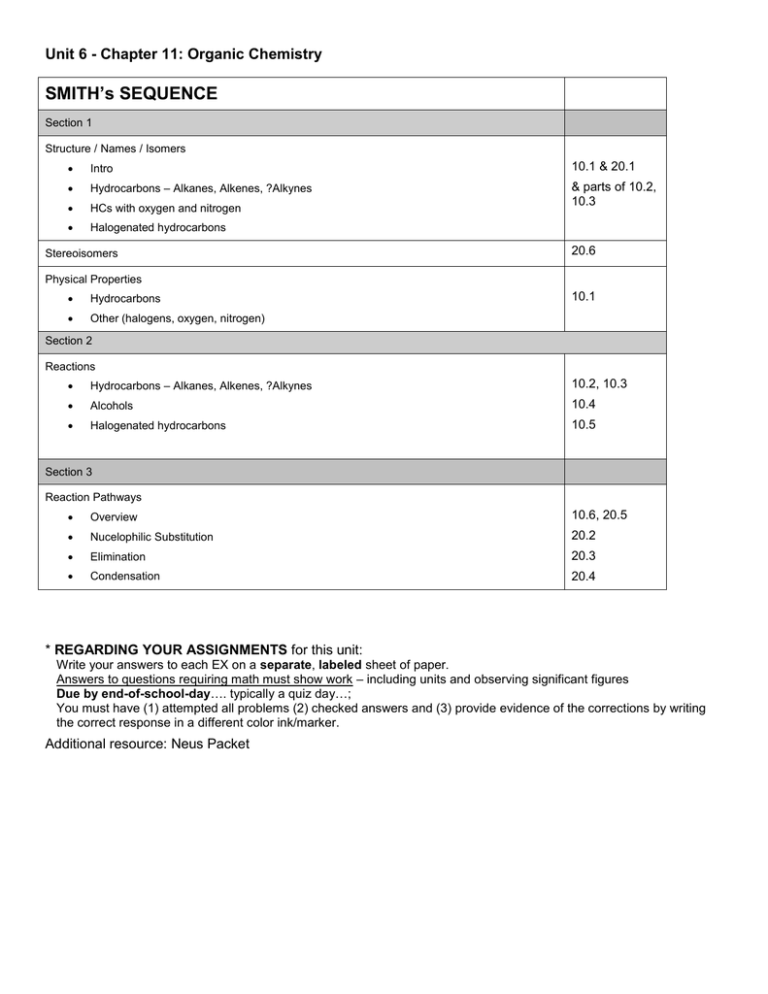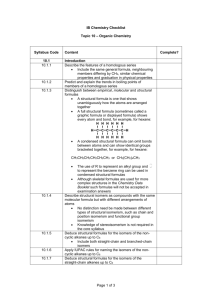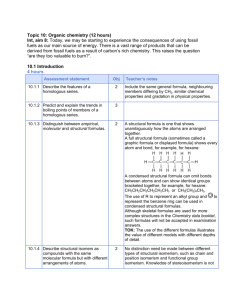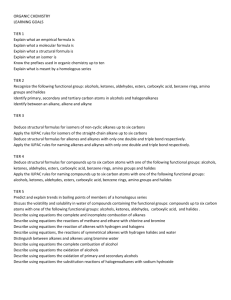Unit 4 - Chapter 5: States of Matter
advertisement

Unit 6 - Chapter 11: Organic Chemistry SMITH’s SEQUENCE Section 1 Structure / Names / Isomers Intro 10.1 & 20.1 Hydrocarbons – Alkanes, Alkenes, ?Alkynes HCs with oxygen and nitrogen & parts of 10.2, 10.3 Halogenated hydrocarbons Stereoisomers 20.6 Physical Properties Hydrocarbons Other (halogens, oxygen, nitrogen) 10.1 Section 2 Reactions Hydrocarbons – Alkanes, Alkenes, ?Alkynes 10.2, 10.3 Alcohols 10.4 Halogenated hydrocarbons 10.5 Section 3 Reaction Pathways Overview 10.6, 20.5 Nucelophilic Substitution 20.2 Elimination 20.3 Condensation 20.4 * REGARDING YOUR ASSIGNMENTS for this unit: Write your answers to each EX on a separate, labeled sheet of paper. Answers to questions requiring math must show work – including units and observing significant figures Due by end-of-school-day…. typically a quiz day…; You must have (1) attempted all problems (2) checked answers and (3) provide evidence of the corrections by writing the correct response in a different color ink/marker. Additional resource: Neus Packet Chapter 10: Organic Chemistry Text Reference What you need to know and be able to do: Objectives Assign How well can you address the stated objective…at this time? Not at all Introduction 10.1.1 10.1 10.1.2 10.1.3 10.1.3 10.1.4 10.1.9 10.1.10 10.1.11 10.1.12 20.1 (HL) 20.1.1 20.1.2 Describe the features of a homologous series Predict and explain the trends in boiling points of members of a homologous series. Discuss the volatility and solubility in water of compounds containing the functional groups: alcohol, aldehyde, ketone, carboxylic acid, and halide. Distinguish between empirical, molecular, and structural formulas. Describe structural isomers as compounds with the same molecular formula but with different arrangements of atoms. Deduce structural formulas for compounds containing up to six carbon atoms with one of the following functional groups: alcohol, aldehyde, ketone, carboxylic acid, and halide. Apply IUPAC rules for naming compounds containing up to six carbon atoms with one of the following functional groups: alcohol, aldehyde, ketone, carboxylic acid, and halide. Identify the following functional groups when present in structural formulas: amino(NH2), benzene ring, esters (RCOOR). Identify primary, secondary, and tertiary carbon atoms in alcohols and halogenoalkanes Deduce the structural formulas for compounds containing up to six carbon atoms with one of the following functional groups: amine, amides, ester, nitrile. Apply IUPAC rules for naming compounds containing up to six carbon atoms with one of the following functional groups: amine, amide, ester, nitrile. Ex 20.1 pp 263-264 # 1-15 Hydrocarbons: Alkanes Deduce structuarl formulas for the isomers of the non-cyclic alkanes up 10.2 10.1.5 10.1.6 10.2.1 10.2.2 10.2.3 10.2.4 Alkenes 10.3 10.1.7 10.1.8 10.3.1 10.3.2 10.3.3 10.3.4 10.3.5 Alcohols 10.4.1 10.4 10.4.2 10.4.3 to C6. Apply IUPAC rules for naming the isomers fo the non-cyclic alkanes up to C6. Explain the low reactivity of alkanes in terms of bond enthalpies and bond polarity. Describe, using equations, the complete and incomplete combustion of alkanes. Describe, using equations, the reactions of methane and ethane with chlorine and bromine. Explain the reactions of methane and ethane with chlorine and bromine in terms of a free-radical mechanism. Deduce structural formulas for the isomers of the straight-chain alkenes up to C6. Apply IUPAC rules for naming the isomers of the straight-chain alkenes up to C6. Describe, using equations, the reactions of alkenes with hydrogen and halogens. Describe, using equations, the reactions of symmetrical alkenes with hydrogen halides and water. Distinguish between alkanes and alkenes using bromine water. Outline the polymerization of alkenes Ex 10.3 pp. 269270 #1-9 Outline the economic importance of the reactions of alkenes Describe, using equations, the complete combustion of alcohols Describe, using equations, the oxidation reactions of alcohols. Determine the products formed by the oxidation of primary and secondary alcohols. Ex 10.4 p. 273 #1-3 So-so I know this! Could Teac h this Text Reference Objectives Assign How well can you address the stated objective…at this time? Not at all Halogenoalkanes 10.5 10.5.1 10.5.2 Describe, using equations, the substitution reactions of halogenoalkanes with sodium hydroxide. Explain the substitution reactions of halogenoalkanes with sodium hydroxide in terms of SN1 and SN2 mechanisms. EX 10.5 p. 274 #1-5 Reaction Pathways 10.6 20.5 Deduce reaction pathways given the starting materials and the product. 10.6.1 & 20.5.1 Ex 10.5 p. 276 #1-7 Nucleophilic Substitution Reactions 20.2 20.2.1 20.2.2 20.2.3 20.2.4 20.2.5 Explain why the hydroxide ion is a better nucelophile than water Ex 20.2 Describe and explain how the rate of nucleophilic substitution in halogenoalkanes by the hydroxide ion depends on the identity of the halogen. Describe and explain how the rate of nucleophilic substitution in halogenoalkanes by the hydroxide ion depends on whether the halogenoalkane is primary, secondary, or tertiary. Describe, using equations, the substitution reactions of halogenoalkanes with ammonia and potassium cyanide. Explain the reactions of primary halogenoalkanes with ammonia and potassium cyanide in terms of the SN2 mechanism. pp. 279280 # 1-5 Elimination Reactions 20.3 20.3.1 20.3.2 Describe, using equations, the elimination of HBr from bromoalkanes Ex 20.3 Describe and explain the mechanism for the elimination of HBr from bromoalkanes. p. 281 # 1-5 Condensation Reactions 20.4 20.4.1 20.4.2 20.4.3 20.4.4 20.4.5 Describe, using equations, the reactions of alcohols with carboxylic acids to form esters, and state the uses of esters. Describe, using equations, the reaction s of amines with carboxylic acids. Deduce the structures of the polymers formed in the reactions of alcohols with carboxylic acids. Deduce the structures of the polymers formed in the reactions of amines with carboxylic acids. Outline the economic importance of condensation reactions. Ex 20.4 p. 282 # 1-5 Stereoisomerism 20.6 20.6.1 20.6.2 20.6.3 20.6.4 20.6.5 20.6.6 20.6.7 Describe stereoisomers as compounds with the same structural formula but with different arrangements of atoms in space. Describe and explain geometrical isomerisms in non-cyclic alkenes. Describe and explain geometrical isomerism in C3 and C4 cycloalkanes. Explain the difference in the physical and chemical properties of geometrical isomers. Describe and explain optical isomerism in simple organic molecules. Outline the use of a polarimeter in distinguishing between optical isomers. Compare the physical and chemical properties of enantiomers Ex 20.6 p. 288 # 1-6 So-so I know this! Could Teach this






